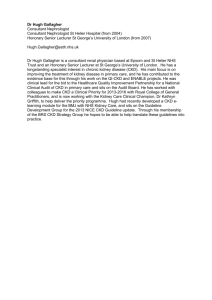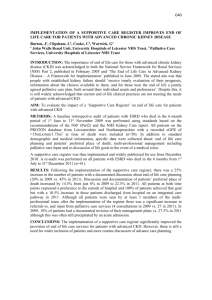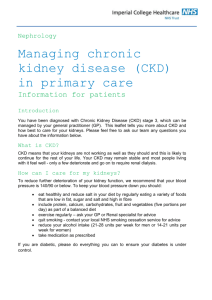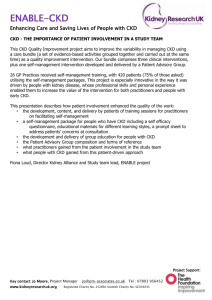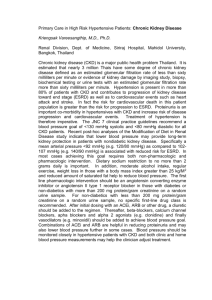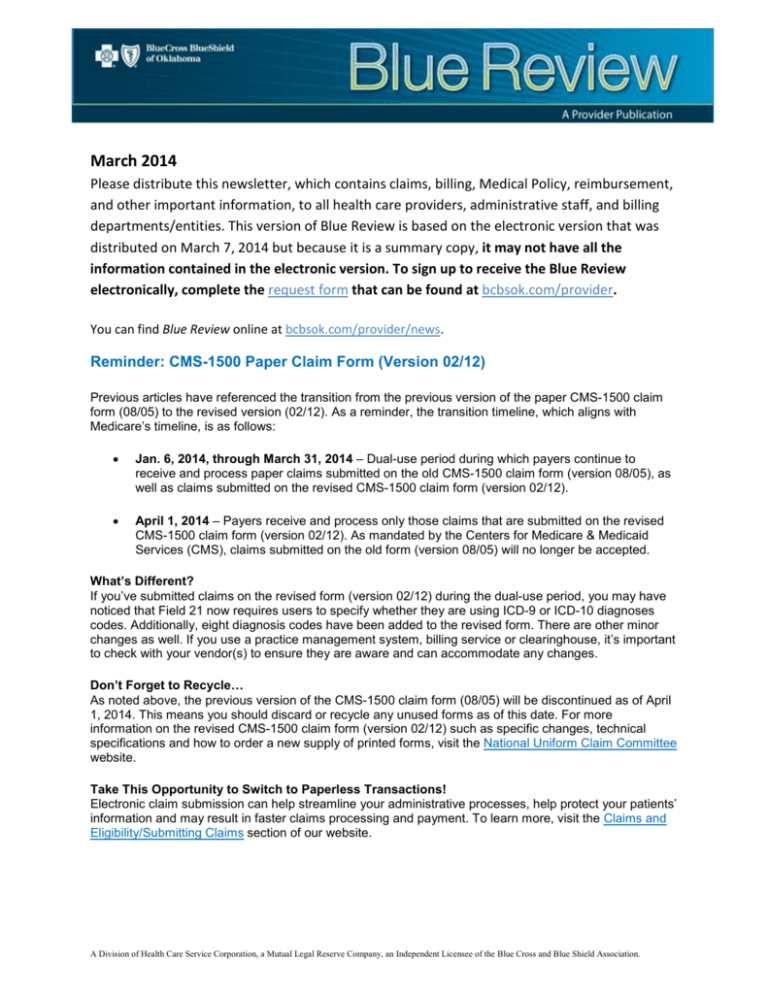
March 2014
Please distribute this newsletter, which contains claims, billing, Medical Policy, reimbursement,
and other important information, to all health care providers, administrative staff, and billing
departments/entities. This version of Blue Review is based on the electronic version that was
distributed on March 7, 2014 but because it is a summary copy, it may not have all the
information contained in the electronic version. To sign up to receive the Blue Review
electronically, complete the request form that can be found at bcbsok.com/provider.
You can find Blue Review online at bcbsok.com/provider/news.
Reminder: CMS-1500 Paper Claim Form (Version 02/12)
Previous articles have referenced the transition from the previous version of the paper CMS-1500 claim
form (08/05) to the revised version (02/12). As a reminder, the transition timeline, which aligns with
Medicare’s timeline, is as follows:
•
Jan. 6, 2014, through March 31, 2014 – Dual-use period during which payers continue to
receive and process paper claims submitted on the old CMS-1500 claim form (version 08/05), as
well as claims submitted on the revised CMS-1500 claim form (version 02/12).
•
April 1, 2014 – Payers receive and process only those claims that are submitted on the revised
CMS-1500 claim form (version 02/12). As mandated by the Centers for Medicare & Medicaid
Services (CMS), claims submitted on the old form (version 08/05) will no longer be accepted.
What’s Different?
If you’ve submitted claims on the revised form (version 02/12) during the dual-use period, you may have
noticed that Field 21 now requires users to specify whether they are using ICD-9 or ICD-10 diagnoses
codes. Additionally, eight diagnosis codes have been added to the revised form. There are other minor
changes as well. If you use a practice management system, billing service or clearinghouse, it’s important
to check with your vendor(s) to ensure they are aware and can accommodate any changes.
Don’t Forget to Recycle…
As noted above, the previous version of the CMS-1500 claim form (08/05) will be discontinued as of April
1, 2014. This means you should discard or recycle any unused forms as of this date. For more
information on the revised CMS-1500 claim form (version 02/12) such as specific changes, technical
specifications and how to order a new supply of printed forms, visit the National Uniform Claim Committee
website.
Take This Opportunity to Switch to Paperless Transactions!
Electronic claim submission can help streamline your administrative processes, help protect your patients’
information and may result in faster claims processing and payment. To learn more, visit the Claims and
Eligibility/Submitting Claims section of our website.
A Division of Health Care Service Corporation, a Mutual Legal Reserve Company, an Independent Licensee of the Blue Cross and Blue Shield Association.
ICD-10 Testing with BCBSOK to Begin April 1, 2014
The Oct. 1, 2014, federally mandated* transition to ICD-10 is only months away. Providers, payers and all
other HIPAA-covered entities should be preparing for the transition.
Blue Cross and Blue Shield of Oklahoma (BCBSOK) is beginning ICD-10 provider testing – an important
readiness activity recommended by the U.S Department of Health and Human Services (HHS) and other
industry organizations. We will be testing electronic professional and institutional claim submissions
(837P and 837I transactions) and Electronic Remittance Advice (835 ERA) transactions with a crosssection of providers.
BCBSOK has scheduled ICD-10 provider testing to begin in April 2014, and continue through Sept. 15,
2014. We will share our findings, suggestions and recommendations – along with the results revealed
during this 6-month testing program – with all BCBSOK contracted providers through the Blue Review.
Our provider testing will allow both providers and us to:
•
•
•
•
Confirm BCBSOK’s ability to accept and process ICD-10 codes submitted on electronic claims
(837 transactions.)
Understand the possible operational impact of electronically submitted claims with providergenerated ICD-10 codes prior to the Oct. 1 implementation.
Confirm BCBSOK’s ability to return an 835 ERA transaction on claims submitted with ICD-10
codes.
Increase mutual confidence in the ICD-10 readiness capabilities.
BCBSOK is currently contacting providers for testing. Providers who are not part of the initial testing
phase may have the opportunity to test with BCBSOK in subsequent phases.
Visit our provider website at bcbsok.com for more information about ICD-10 preparation, implementation,
training, technology planning and more.
*Mandated by the Department of Health and Human Services through the Centers for Medicare and
Medicaid Services (CMS) Office of E-Health Standards and Services (OESS)
A Closer Look: Documentation and Coding for Chronic Kidney Disease
This month’s Blue Review highlights documentation and coding for Chronic Kidney Disease (CKD) under
the ICD-9-CM and ICD-10-CM code sets.
The National Kidney Foundation defines CKD as a “condition characterized by a gradual loss of kidney
function over time1”. CKD is classified to category 585–Chronic Kidney Disease, in ICD-9-CM. Fourth
digit assignment indicates the stage of the disease which is based on severity. The stage is determined
by the degree of kidney damage and the Glomerular filtration rate (GFR), an indicator of how well the
kidneys are functioning. The severity is designated by Stages I–V. CKD can progress to End Stage Renal
Disease (ESRD), which is also reported using a code from the 585 category. The code for end stage
renal disease (585.6) cannot be assigned without supporting documentation from the provider.
Under ICD-10-CM, CKD is reported under category N18, with fourth digit assignment indicating the stage
of the disease. In ICD-9-CM and ICD-10-CM, the code for ESRD is found in the same category as the
codes for CKD.
When coding CKD in ICD-9-CM or ICD-10-CM, coding guidelines provide instruction to also assign
diagnosis codes for any associated conditions.
Page 2
Blue Review • March 2014 • bcbsok.com
Hypertensive Chronic Kidney Disease
Hypertension is one of the leading causes of CKD and, together with diabetes, is responsible for nearly
two-thirds of CKD cases.ICD-9-CM presumes a cause-and-effect relationship and classifies CKD with
hypertension as hypertensive CKD. The Official ICD-9-CM Guidelines for Coding and Reporting provide
guidance related to hypertensive CKD coding. Assign codes from category 403-Hypertensive CKD, when
conditions classified to category 585-CKD are present with hypertension.
To accurately report a diagnosis of hypertensive CKD using diagnosis code 403, it is important to select
the appropriate fourth digit to indicate whether the hypertension is classified as malignant (0), benign (1)
or unspecified (9). Fifth digit assignment identifies the stage of the kidney disease. CKD stage I-IV or
unspecified is indicated by a fifth digit assignment of (0), while CKD stage V or ESRD is indicated by a
fifth digit assignment of (1).
The appropriate code from category 585-CKD, should be reported as discussed above, to identify the
stage of CKD.
Similar to the current ICD-9-CM coding system, ICD-10-CM requires two codes to accurately report a
diagnosis of hypertensive CKD. The first code indicates the presence of both hypertension and CKD, the
second code identifies the stage of CKD. Under the ICD-10-CM coding system, there is no distinction
between benign, malignant, or unspecified hypertension as is under the ICD-9-CM code set.
Diabetic Chronic Kidney Disease
February’s Blue Review highlighted documentation and coding for diabetes and related diabetic
diagnoses. As previously mentioned, diabetes is responsible for nearly two-thirds of CKD cases. Recall
that under category 250 Diabetes mellitus, ICD-9-CM requires a fourth digit to identify associated
conditions and a fifth-digit to identify the type of diabetes mellitus, and whether the diabetes is controlled
or uncontrolled.
In ICD-9-CM, when CKD is due to diabetes, it is reported with code 250.4X and the documented stage of
CKD is reported with code 585.X.
Under ICD-10, CKD due to diabetes has a fourth and fifth digit designation. The fourth digit “2” indicates
the underlying condition is a kidney complication. The fifth digit, also a “2”, indicates the complication is
associated with chronic kidney disease. Additionally, assign a code from category N18 to identify the
stage of the CKD.
End Stage Renal Disease (ESRD)
In the United States, ESRD is an administrative term based on conditions for health care payment by the
Medicare ESRD Program for patients treated with dialysis or transplantation due to permanent kidney
failure. ESRD is the most severe form of CKD and should only be assigned when the provider documents
ESRD. If both a stage of CKD and ESRD are documented, ESRD is the only code that should be
assigned per ICD-9-CM and ICD-10-CM guidelines. ESRD is reported as 585.6 in ICD-9-CM and N18.6 in
ICD-10-CM. Additional guidance is provided in ICD-10-CM under N18.6 to use additional code to identify
dialysis status (Z99.2).
Hypertensive Heart and Chronic Kidney Disease
When both hypertensive kidney disease and hypertensive heart disease are stated in the diagnosis, ICD9-CM guidelines require assignment of codes from category 404-Hypertensive heart and CKD. With
hypertensive CKD, ICD-9-CM and ICD-10-CM assumes a relationship between the hypertension and the
CKD, whether or not the condition is so designated. This assumption is the same under ICD-10-CM.
Assign an additional code from category 428-Heart failure, to identify the type of heart failure. If a causal
relationship is not documented, the heart condition and hypertension are coded separately and
sequenced according to the circumstances of the admission/encounter.
ICD-10-CM guidelines for reporting hypertensive heart and CKD are very similar to ICD-9-CM. ICD-10CM instructs the user to assign codes from category I13-Hypertensive heart and CKD, when both
Page 3
Blue Review • March 2014 • bcbsok.com
conditions are stated in the diagnosis. Category I13 represents combination codes that include
hypertension, heart disease and CKD. Therefore, if a patient has each of these conditions, a code from
I13 should be assigned. Additionally, the appropriate code to identify the stage of the CKD is assigned in
both ICD-9-CM and ICD-10-CM.
References:
1. The National Kidney Foundation About Chronic Kidney Disease Optum ICD-9-CM for HospitalsVolumes 1, 2 & 3 2014
2. Professional Optum ICD-10-CM The Complete Official Draft Code Set 2014 Draft
3. KDIGO 2012 Clinical Practice Guidelines for CKD Evaluation and Management
ClaimsXtenTM Second Quarter 2014 Updates
Blue Cross and Blue Shield of Oklahoma (BCBSOK) reviews new and revised Current Procedural
Terminology (CPT®) and HCPCS codes on a quarterly basis. Codes are periodically added to or deleted
from the ClaimsXten software by McKesson and are not considered changes to the software version.
BCBSOK will normally load this additional data to the BCBSOK claim processing system within 60 to 90
days after receipt from McKesson and will confirm the effective date on the BCBSOK website. Advance
notification of updates to the ClaimsXten software version (i.e., change from ClaimsXten version 4.1 to
4.4) will continue to be posted on the BCBSOK provider website.
Beginning on or after May 19, 2014, BCBSOK will enhance the ClaimsXten code auditing tool by adding
the second quarter codes and bundling logic into our claim processing system.
The ClaimsXten tool offers flexible, rules-based claims management with the capability of creating
customized rules, as well as the ability to read historical claims data. ClaimsXten can automate claim
review, code auditing and payment administration, which we believe results in improved performance of
overall claims management.
To help determine how coding combinations on a particular claim may be evaluated during the claim
adjudication process, you may continue to utilize Clear Claim ConnectionTM (C3). C3 is a free, online
reference tool that mirrors the logic behind BCBSOK’s code-auditing software. Refer to our website at
bcbsok.com/provider for additional information on gaining access to C3.
For updates on ClaimsXten, watch the News and Updates on our provider website, as well as upcoming
issues of Blue Review.
Checks of eligibility and/or benefit information are not a guarantee of payment. Benefits will be
determined once a claim is received and will be based upon, among other things, the member’s eligibility
and the terms of the member’s certificate of coverage applicable on the date services were rendered.
ClaimsXten and Clear Claim Connection are trademarks of McKesson Information Solutions, Inc., an
independent third party vendor that is solely responsible for its products and services.
CPT Copyright 2014 American Medical Association (AMA). All rights reserved. CPT is a registered
trademark of the AMA.
Not Enrolled in Electronic Funds Transfer?
Electronic Funds Transfer (EFT) is a convenient, confidential and secure method of payment. Using EFT
means your payments are delivered directly to the financial institution of your choice. This alternative to
receiving paper checks can help save you time while reducing the risk of lost or misrouted payments. In
general, funds will be transferred to the provider’s bank in two banking days, after the claim is finalized,
depending on your payment schedule.*
Page 4
Blue Review • March 2014 • bcbsok.com
There’s no cost to enroll, and the enrollment process is easier than ever. BCBSOK independently
contracted providers who are registered with Availity® may complete the EFT and Electronic Remittance
Advice (ERA) enrollment process online via the secure Availity provider portal. Please note that you must
be a registered Availity user to complete the online enrollment process – visit availity.com for more
information. Or, to enroll by submitting a paper form, complete the Electronic Funds Transfer (EFT)
Authorization Agreement, which is available in the Claims and Eligibility/Electronic Commerce section of
our website at bcbsok.com/provider.
*Add one day if the normal day falls on a banking holiday. EFT payment dates also may be affected by
our corporate holiday schedule. Visit the Claims and Eligibility/Electronic Commerce section of our
website at bcbsok.com/provider for details.
Availity is a registered trademark of Availity, LLC. Availity is a separate company that operates a health
information network to provide electronic information exchange services to medical professionals. Availity
provides administrative services to BCBSOK. BCBSOK makes no endorsement, representations or
warranties regarding any products or services offered by independent third party vendors. If you have any
questions about the products or services offered by such vendors, you should contact the vendors
directly.
In Every Issue
Featured Tip: Electronic Options for Pharmacy Prior Authorization Requests
Blue Cross and Blue Shield of Oklahoma (BCBSOK) continues to enhance the process for submitting PA
requests for drugs that are a part of our Pharmacy Prior Authorization (PA) program.
In our November 2013 Blue Review, we announced the availability of CoverMyMeds® for electronic
completion and submission of PA requests for drugs that may be considered for coverage under the
member’s pharmacy benefit. A link to CoverMyMeds is available in the Pharmacy Program section of our
website at bcbsok.com/provider; a link is also available to registered users on the Availity portal.
CoverMyMeds is available for PA requests for members who have their pharmacy benefit administered by
Prime Therapeutics; exclusions may apply.
Now, you can also submit medical pharmacy PA requests online using iEXCHANGE®, our Web-based
tool that accepts prior authorization requests 24 hours a day, seven days a week.* In addition to PA
requests for medical/surgical and behavioral health services, iEXCHANGE supports outpatient PA
requests for the following specialty drugs, which may be considered for coverage under the member’s
medical benefit:
•
•
•
•
•
Avastin
Mybloc
Reclast
Botox
Remicade
Using online options for specialty drug PA requests replaces the need to fax paper forms to BCBSOK. It
provides immediate confirmation upon receipt, without the need to resubmit requests or call to check
status.
Learn More About iEXCHANGE
For more about how to use iEXCHANGE or upcoming training opportunities, please consult the following
resources:
•
To get started using iEXCHANGE, new users can register by completing the online enrollment
form found on the Provider Tools page in the Education and Reference Center of our Provider
Page 5
Blue Review • March 2014 • bcbsok.com
website. Upon completion, users will receive login information to access iEXCHANGE via the
Provider login page. iEXCHANGE is also accessible to registered users via a “single sign-on”
feature at availity.com.
•
For reference, a new Submitting an Outpatient Pharmacy Preauthorization Tip Sheet is available
on the Provider Tools page in the Education and Reference Center of our Provider website. This
tip sheet offers step-by-step instructions for submitting a medical pharmacy PA request using the
iEXCHANGE tool.
•
Additional training for iEXCHANGE is available upon request by contacting the iEXCHANGE
training team at ProviderOutreachEducation@bcbsok.com.
Learn More About Our Pharmacy PA Program
Please be sure to visit the Prior Authorization/Step Therapy Forms page in the Pharmacy Program
section of our website for details and helpful resources. Also continue to check the News and Updates on
our website, as well as upcoming issues of Blue Review for announcements on program enhancements
related to pharmacy optimization and other important initiatives.
Please note that the listing of any particular drug or classification of drugs and/or the fact that a service
has been preauthorized/pre-certified is not a guarantee of payment. Benefits will be determined once a
claim is received and will be based upon, among other things, the member’s eligibility and the terms of
the member’s certificate of coverage applicable on the date services were rendered. Members should
refer to their certificate of coverage for more details, including benefits, limitations and exclusions.
Regardless of benefits, the final decision about any medication is between the member and their health
care provider.
CoverMyMeds is a registered trademark of CoverMyMeds LLC, an independent third party vendor that is
solely responsible for its products and services. BCBSOK makes no endorsement, representations or
warranties regarding any products or services offered by independent third party vendors. If you have any
questions regarding the products or services they offer, you should contact the vendor(s) directly.
Availity is a registered trademark of Availity, LLC. Availity is a separate company that operates a health
information network to provide electronic information exchange services to medical professionals. Availity
provides administrative services to BCBSOK. BCBSOK makes no endorsement, representations or
warranties regarding any products or services offered by independent third party vendors. If you have any
questions about the products or services offered by such vendors, you should contact the vendors
directly.
Prime Therapeutics LLC is a pharmacy benefit management company. BCBSOK contracts with Prime to
provide pharmacy benefit management, prescription home delivery and specialty pharmacy services.
BCBSOK, as well as several other independent Blue Cross and Blue Shield Plans, has an ownership
interest in Prime.
*With the exception of the third Sunday of every month when the system will be unavailable from 11 a.m.
to 2 p.m. CT.
Third party brand names are the property of their respective owners.
Web Changes
•
•
•
•
Added January 2014 Blue Review to Education and Reference Center/News and Updates.
Added February 2014-Blue Review to Education and Reference Center/News and Updates.
Added ClaimsXten Second Quarter 2014 Updates to Education and Reference Center/News and
Updates.
Updated the Predetermination Form located under Education and Reference Center/Forms.
Page 6
Blue Review • March 2014 • bcbsok.com
•
•
•
•
•
•
•
Updated the IDC-10 Resource Guide located under Standards and Requirements/Related
Resources.
Updated the eRM Training Webinar Schedule located under Education and Reference/Tools.
Added a Claim Status page located under Claims and Eligibility/Claims Status.
Added an Eligibility and Benefits page located under Claims and Eligibility/Eligibility and Benefits.
Added NDC March 2014 Fee Schedule to the secure provider portal (which you can log in to) on the
home page of the BBCBSOK provider website.
Updated NDC Billing FAQ's to Pharmacy Program/Related Resources.
Added Claim Research Tool Webinars to Education and Reference Center/News and Updates.
BCBSOK Online Provider Orientation
The “Online Provider Orientation” is a convenient and helpful way for providers to learn about the online
resources available to them.
Medical Policy Reminder
Approved new or revised HCSC Medical Policies and their effective dates are posted on the BCBSOK
website the first day of each month. These policies may impact your reimbursement and your patients’
benefits. You may view all active and pending Policies or view draft Medical Policies and provide
comments. These can be accessed on the Standards and Requirements page of our Provider website.
While some information on new or revised Medical Policies may occasionally be published for your
convenience, please visit bcbsok.com/provider for access to the most complete and up-to-date
information.
Training Schedules
ICD-10
eRM Training
Page 7
Blue Review • March 2014 • bcbsok.com




